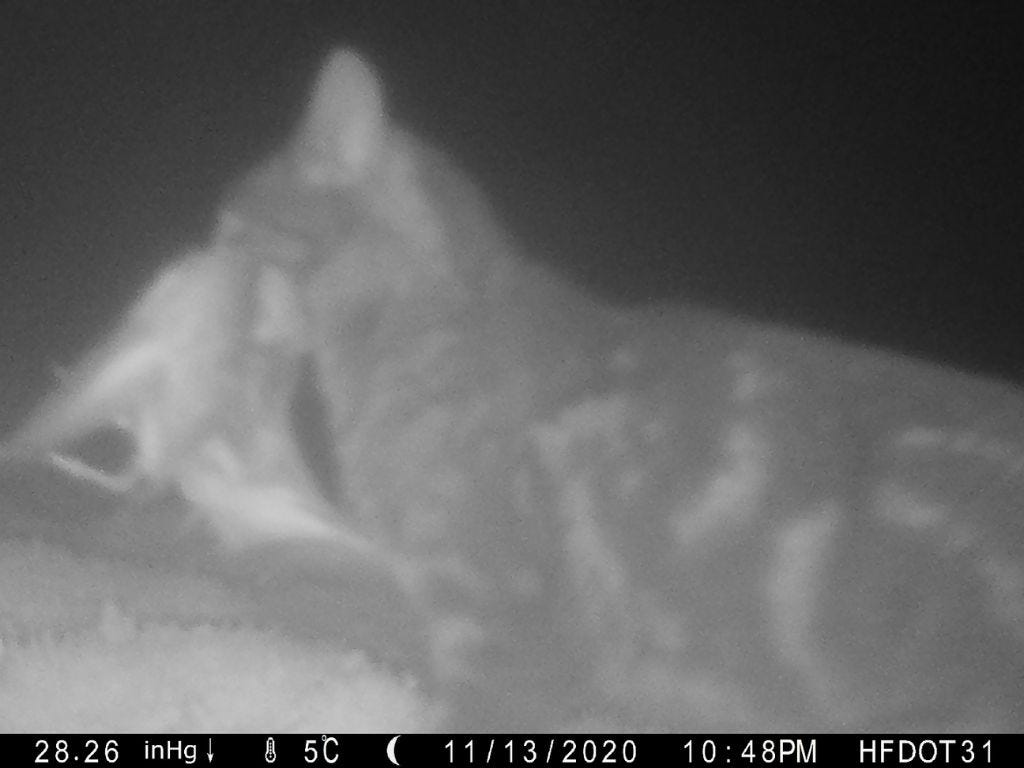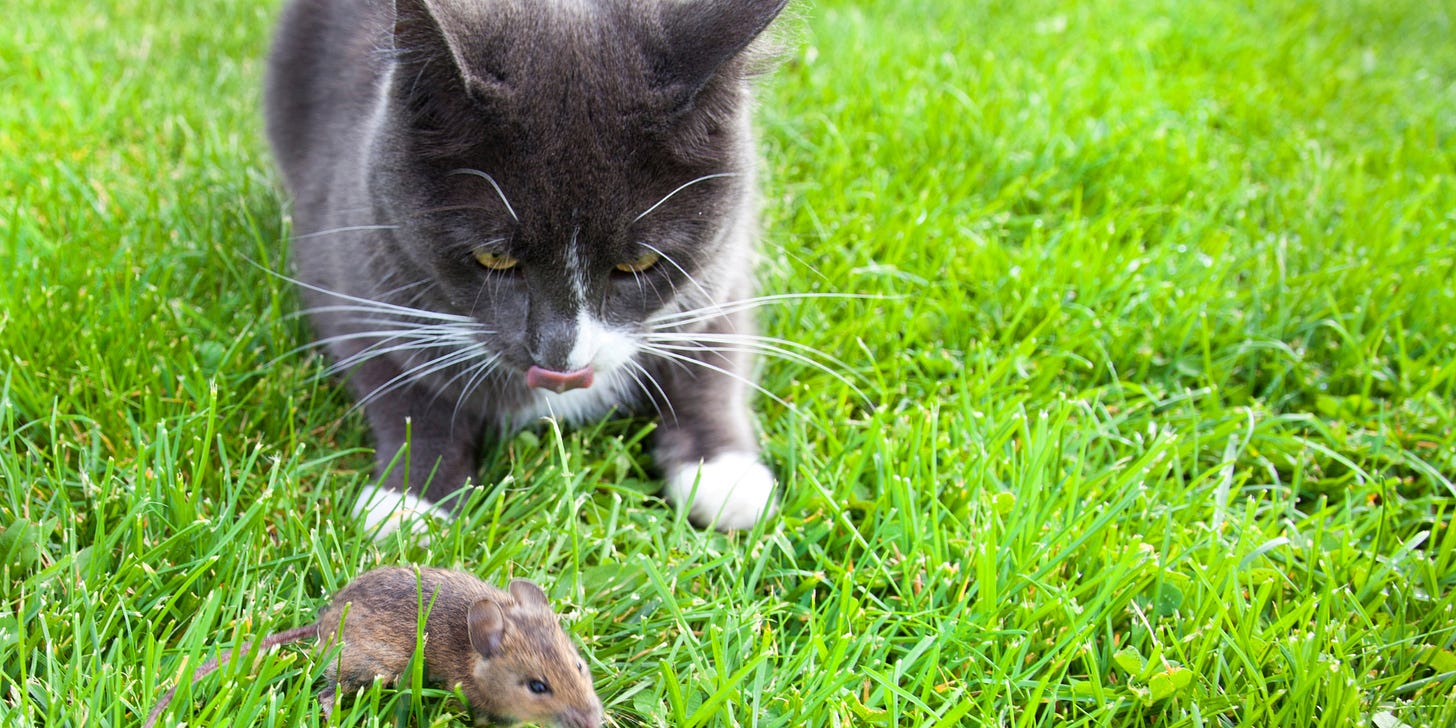Controversial Post: How Can We Be 'Predator-Free' by 2050 if we Don't Tackle Cats...?
Warning: this post contains pictures of cats and their prey.
“But what about cats?”
I hear this whispered by conservationists who see the damage cats do, but fear ‘cativists’ (cat activists) and saw what happened to Gareth Morgan.
It is a taboo subject. People love cats - and I totally get it. Talking about our beloved pets as pests and how we need to control them is super confronting and uncomfortable. But that doesn’t mean we shouldn’t talk about it. We are all grown ups and ultimately want the same thing - a happy, healthy environment for all to thrive in. As such, we should be able to discuss uncomfortable things without resorting to name calling. (Although, my experience online indicates maybe not…)
Aotearoa has the highest species extinction rate in the world. We need to take protecting our biodiversity and native species far more seriously. Beyond the fact it’s the right thing to do, protecting nature will save NZ $270 billion1 over the next 50 years according to WWF and EY. 27% of our GDP is directly related to our natural capital (and of course the remaining 73% indirectly depends on having a healthy planet…).
There are lots of community groups doing excellent work around the motu already, but as the coalition government continues to fund fossil fuel extraction instead of protecting nature, more of us should get involved2.
I find this a horrible conversation. I hate killing pests and find it very upsetting. It’s the absolute worst part of rewilding my lifestyle block, but it is so important and part of being kaitiaki (guardians), because study after study shows just how much healthier biodiversity is when we remove pest species34. It’s not the animal’s fault that it’s in the wrong place - it’s ours. It is morally imperative that we do everything we can to undo our mistake but do so in a way that causes the least pain and suffering.

Cats by numbers:
100 million5. That’s how many birds are killed by cats in Aotearoa every year. That number is quoted on several regional council sites but I can’t find the ultimate source and other sources vary massively. Regardless, it’s tens of millions. Included in that total are the 18 million6 killed by domestic (pet) cats.
637. The number of extinctions cats are responsible around the world. Still not as many as us, but not a small number.
120. That’s how many kittens a cat can have in it’s lifetime, (though many sources peg this much higher - Predator Free 2050 puts it at 300).
2.5 million8. The number of feral cats currently roaming the country according to various sources, though there are doubts on how accurate this is.
1.4 million9. The number of domestic cats - Aotearoa has one of the highest rates of cat companionship in the world.
10710. That’s how many bats one cat killed in Ohakune in just one week in 2010.
20%11. In just two years, cats killed 20% of monitored Kea in Arthurs Pass.
Scientists and pest control experts group cats into three; feral, stray and pet.
Pets are of course someone’s beloved family member and largely dependent on them for food and shelter.
Strays are semi-dependent on humans and are often fed by people. Their offspring tend to become feral.
Feral cats are wild animals with no interaction with people. They grow bigger, they’re tougher and fitter than domestic cats. They cause the lions share of the damage to our native species, but not all of it.
Pet and stray cats are not the target of pest control conversations of course, but abandoned pets lead to an increase in feral cats, and domestic cats still kill 18 million birds annually, so responsible pet ownership is really important.
But if we remove cats, don’t we get loads of rats and other pests?
Cats don’t keep rats and mice in check.
Studies that track what happens when large numbers of feral cats are removed in Aotearoa show that rodent population bounce-backs are an exception, not the rule. A replicated field experiment in central North Island forests saw no surge in either ship rats or mice after a top-predator was taken out as it was food supply, not predation that maintained populations. Modelling and monitoring on Aotea likewise conclude that losing cats does not unleash a wave of rats or rabbits, and the net biodiversity gain from cat removal is positive1213.
More studies back this up too. Surveys across NZ farmland showed feral cats on farmland ate more birds, lizards and large invertebrates on average than rodents or rabbits, confirming their impact on native fauna rather than pest mammals14. On Raoul Island seabirds were the dominant stomach contents, with rats coming second15.
Where cats have been taken out, vegetation, invertebrates and small native birds rebound quickly, once companion control of rodents is in place. Long-term monitoring on Great Barrier recorded higher seedlings and lizard densities in pest-free zones16.
Can’t we just neuter feral cats to be more humane?
Unfortunately, science says no. Trap-neuter-return is a welfare tool rather than a conservation one. Population viability models and field audits agree that you must spay/neuter at least 75% of fertile adults every year just to hold numbers steady, and that just doesn’t happen in real life17.
A 2023 Manaaki Whenua review of management options ranks removal (rehoming when possible, humane euthanasia when not) ahead of trap-neuter-return for biodiversity goals18.
So the best options for the environment are to remove cats from the environment, in the most humane way possible. Which is a hard argument for a lot of cat lovers to stomach.
People try to deflect this conversation by commenting how we need to be focused on other pests too, like stoats and rats. Absolutely - but we know this. It is widely accepted that they are pest species and there are comprehensive pest control programs in place. That isn’t the case for cats yet and that’s why we need to talk about it. The fact cats weren’t included in Predator Free 2050 is telling.
All in all, more needs to be done. There are some feral cat programs around the country, but by and large, it tends to be something people avoid talking about. There was a study published demonstrating damage cats were doing and it was posted on Facebook, by one of the news sites. The comments were overwhelmingly aggressive - talking about anti-cat propaganda, how it was BS, how people just hated cats and they didn’t do any real damage. It was… perplexing. Irritatingly I can’t remember or find who posted it, so can’t link it for you. But it was an interesting insight into what people talking about this face.
A random, but interesting fact - cats can lead to the deaths of dolphins. I know - I read this and was skeptical too, but it’s a solid link. Cats (and lots of other animals including us) can carry a parasite called Toxoplasma gondii. But cats are the only animals in which T. gondii can sexually reproduce and when the parasite releases oocysts (eggs), they are excreted by the cat, end up in waterways and infect marine mammals. Unfortunately the infection can be fatal in dolphins and DOC have estimated that 334 Hector’s dolphins and 2 Māui dolphins die every year from the infection.
There are some obvious (though not necessarily easy) solutions to this:
For responsible pet guardians:
Pet cats should be registered and neutered/spayed1920. (The neutered/spayed requirement should also go for dogs, which are of course already required to be registered.) Exceptions for breeders and other special cases of course.
Cat guardians should ensure they feed their cat well, use a bell intermittently (leaving a bell on all the time means the cat learns to hunt silently with it on - so pattern disruption is helpful), keep their cat inside at night, and provide toys so they are less likely to get bored. None of them are slam dunk solutions, but they have all been shown to help. Even if you don’t think your cat hunts because they don’t bring anything home - studies show they bring less than 20% of their hunts home as trophies21.
Have you thought about a catio22?
For everyone to do, or think about:
Education about the risk that cats pose should be talked about more. There are some people who simply will not accept that Whiskers will kill something given the chance and become bizarrely outraged when this conversation comes up. I get it - it’s an emotive issue. But that is no reason for people not to talk about this more often.
Support the legislation that cats should be registered and desexed23.
Support or get involved with programs, like Predator Free 2050. But feral cats should really be a part of PF2050. If they are not, then really how effective will the program be?
Do you want to help with trapping pests? It’s something that is incredibly confronting for a lot of people (me, I am pathetic when it comes to this sort of thing), but it’s really important. If so, there are lots of resources on how to do this humanely in the resources below, or with your local council.
So there are things we can all do to help, and by no means is that list exhaustive.
As an aside, I saw someone mention the other day that our hatred of cats is rooted in misogyny. Maybe there is a grain of truth to it because of course ‘cat lady’ is used as some bizarre insult quite broadly. I say bizarre because why is living your life on your own terms and sharing it with animals something to be mocked? I think I’m living the dream with my 69 animals, though none of them are cats. Does that make me a crazy horse lady?
But that is not why I’m writing this. Unfortunately, cats are prolific killers, do demonstrable harm to our native wildlife and are largely unchecked in Aotearoa. If we put in place some basic controls, cat lovers will be able to have their pets, native birds will be safer, and we might be able to lower our abysmal extinction numbers.
But perhaps not, because these sorts of conversations are basically political suicide.
Sources and resources:
Some excellent resources if you want to know more (see also list of sources in the footnotes).
Predator Free 2050
Forest & Bird
Goodnature
https://www.ey.com/content/dam/ey-unified-site/ey-com/aus-nzl/documents/pdfs/ey-wwf-summit-report.pdf
https://www.rnz.co.nz/news/national/494696/sanctuary-calls-for-feral-cats-to-be-included-in-predator-free-2050-strategy
https://static1.squarespace.com/static/5d1bf13a3f8e880001289eeb/t/5f768e8a17377653bd1eebef/1601605338749/Companion+Animals+in+NZ+2020+%281%29.pdf
https://web.archive.org/web/20130219153932/http://www.doc.govt.nz/about-doc/news/media-releases/2010/cat-nabbed-raiding-the-mothership/
https://www.researchgate.net/publication/8087243_Use_of_matrix_population_models_to_estimate_the_efficacy_of_euthanasia_versus_trap-neuter-return_for_management_of_free-roaming_cats
https://www.researchgate.net/publication/226698533_Prospects_for_the_eradication_of_rats_from_a_large_inhabited_Island_Community_based_ecosystem_studies_on_Great_Barrier_Island_New_Zealand






